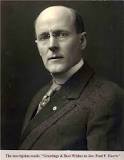 Paul Harris, a twenty-eight-year-old practicing attorney, set up his law practice in Chicago. Nine years later, Paul, then an outstanding attorney, with a thriving law office had dinner with his closest friend, Chicago coal dealer Silvester Schiele, who had hired Paul to collect a $10.00 debt owed to him. Afterwards they walked up to Room 711 of the Unity Building where they met their host, Gustavus Loehr, a mining engineer; and another friend, Hiram Shorey, a merchant tailor.
Paul Harris, a twenty-eight-year-old practicing attorney, set up his law practice in Chicago. Nine years later, Paul, then an outstanding attorney, with a thriving law office had dinner with his closest friend, Chicago coal dealer Silvester Schiele, who had hired Paul to collect a $10.00 debt owed to him. Afterwards they walked up to Room 711 of the Unity Building where they met their host, Gustavus Loehr, a mining engineer; and another friend, Hiram Shorey, a merchant tailor. Harris proposed a vision he had of a club in Chicago for professionals with diverse backgrounds where they could exchange ideas, form meaningful, lifelong friendships, and give back to their communities. No name was chosen for the group. But they agreed to meet again, and then again...
The Chicago club almost disbanded during the first two years over issues of scope and purpose. A faction opposed to rapid expansion almost derailed the club completely. The club struggled with this issue for years and refused to allow another club to be formed in Chicago, or any nearby city. It was almost three years before a second club was formed, and that one was formed in San Francisco.
Never the less, by the end of 1912, Paul had patiently and skillfully molded his vision of Rotary into a rapidly expanding, well organized, and effective organization, known as the National Association of Rotary Clubs, with Paul as its first president.
The purpose of this organization was to promote the expansion of Rotary and support the clubs as they were added. The Rotary Club of Chicago was club number one, the Rotary Club of San Francisco was club #2, and so on.
The Rotary Club of Dallas Texas (club #39) was charted April 9, 1912. That same month a club in Winnipeg Canada (club #40) was admitted, making Rotary an International organization. By the end of 1912, there were 56 clubs in the Rotary organization, which was aptly renamed, the “International Association of Rotary Clubs”, in which the Rotary Club of Marshall Texas was to become a member seven years later.
During those seven years after the Dallas club was organized, much had been happening behind the scenes; the organization had chosen a name (Rotary), a motto, a logo, had adopted “Ideals”, had established a constitution and bylaws, had begun to hold conventions, and, having a lawyer at the helm, had begun to establish rules and guidelines for clubs to follow.
By the time the Rotary Club of Marshall Texas was founded August 1, 1919 (club #525), Paul’s vision had become an international phenomenon, with clubs in 6 different countries.
The story of the Rotary Club of Marshall Texas began with the relationship between Ike Hochwald of the Great Railroad Supply Store in Marshall and Longview businessman R. Marvin Kelly of Kelly Plow Works in Longview. The story of these two men of vision, is revealed in "The Club And The Town", "The Rotary Club and the City of Longview, Texas, Year by Year from 1920 to 1995", by Eugene W McWhorter:
In 1919 Marvin Kelly was visiting the office of Arthur A. Everts in Dallas when it came time for Mr. Everts to go to the Rotary club of Dallas, so he invited Kelly to be his guest. Kelly was so impressed with this meeting, that he shared the story with his good friend, Ike Hochwald, of Marshall who was in Longview and told him about his wonderful experience of being invited to attend a Rotary meeting in Dallas.
Hochwald was so enthusiastic that he immediately got a group of men together and organized the Marshall Rotary Club June 13, 1919. The club was “officially” admitted to The International Association of Rotary Clubs August 1, 1919, for which we are now,
“Celebrating a Century of Changing Lives in Marshall, and beyond”